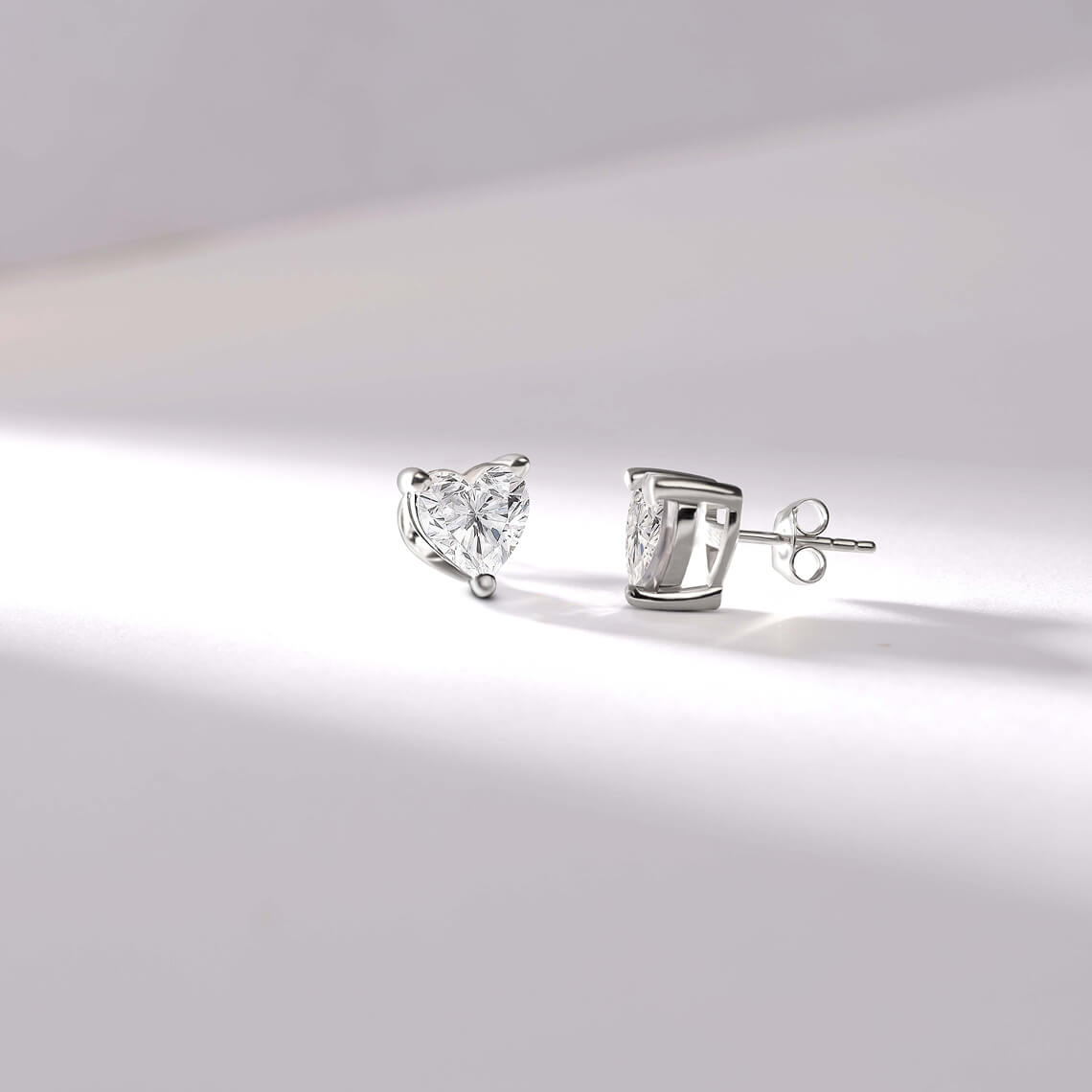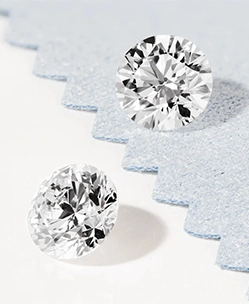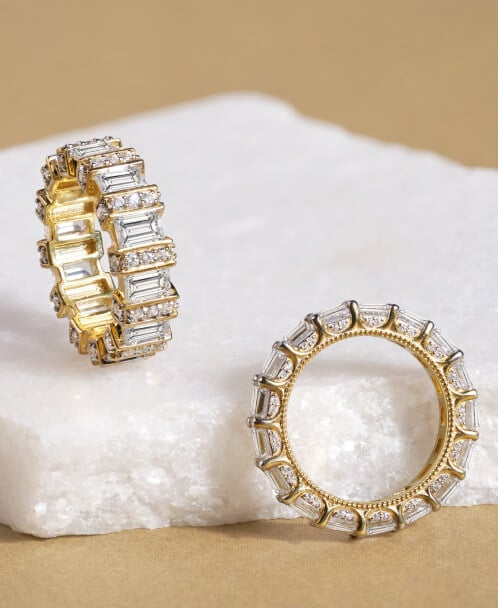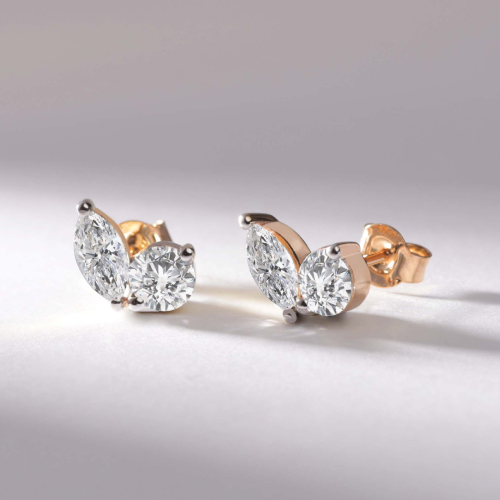The Golden Dilemma: When Choosing Jewelry Gets Tricky
You’ve found that diamond ring of your dreams. Or maybe it’s an irresistible pair of hoops that’s more your speed. Or a tennis bracelet that, to you, can only be described as elegant and fashion-forward. You’re just about to add it to your cart when suddenly, the metal options appear. “14kt or 18kt white gold?” The pre-checkout joy transforms suddenly into an all-too-familiar, one-on-one argument of the mind.
Sound familiar? You’re not alone. Choosing between 14kt vs 18kt white gold can feel like picking a favorite dessert (impossible). Both are absolutely delicious (gold is so delicious, right?) and yet, they both have very different flavors. Wondering which one would suit you best? Don’t worry, this blog will break it all down for you so you can know exactly what to expect from each type of white gold. Soon you’ll be confidently saying “yes” to the white gold that fits your aesthetic, lifestyle and sparkle goals.
Table of Content
Behind the Shine: What Is White Gold, Really?
White gold is a contemporary favorite in jewelry, and for good reason. This silvery version of classic yellow gold maintains the traditional element of yellow gold jewels but with an updated, dazzling hue. White gold is created from an alloy of pure gold and white metals, including nickel, zinc, silver or palladium, often with a rhodium plate that gives it a shiny silver appearance.
Now, here’s the kicker: white gold comes in various “karats” and this is where the 14kt vs 18kt white gold discussion starts. The karat (kt) refers to how much pure gold is present in the alloy.

SHOP Stud Earrings
14kt vs 18kt White Gold: The Core Differences
Let’s get to the heart of the matter. Here’s how 14kt and 18kt white gold stack up:
Gold Purity & Composition
14kt white gold has a composition of 58.3% pure gold and 41.7% alloy metals (nickel, copper, and zinc).
18kt white gold is 75% pure gold, with the remaining 25% made of softer metals like silver or palladium.
More gold is an indicator of more luxury and more softness.
Appearance & Color
Because of its higher percentage of alloys, 14kt white gold tends to be brighter, or “whiter,” initially.
On the other hand, due to its slightly higher gold content, 18kt white gold can appear slightly warmer with more of a luxurious buttery hue
Though both are rhodium plated to keep the shine longer, 18kt doesn’t oxidize as much as the 14kt, requiring less rhodium plating touch-ups over time.
Durability & Hardness
Because it contains more alloyed metals, 14kt white gold is more scratch-resistant than 18kt white gold. It’s also harder and therefore more suitable for active lifestyles.
While 18kt white gold is more apt to get dings, it is still a strong enough metal to hold up to everyday wear if treated correctly
Think of 14kt as your sporty SUV and 18kt as your luxury sedan, they’ll both get you places, just with different perks.
Hypoallergenic Properties
14kt white gold may cause allergic reactions for those with allergies to nickel.
18kt white gold contains less nickel and is a better choice for sensitive skin.

SHOP Solitaire Necklaces
What Fits Your Lifestyle? Matching Metal to Daily Wear
Ultimately, there’s only one thing that matters, how your jewelry will fit into your daily life.
Always on the go?
Do you like to stack rings, lift weights, or just throw your jewelry into a gym bag? 14kt white gold is your most durable and dependable friend that can handle the wear and tear of your hectic lifestyle. It can handle all encounters.
Minimalist and mindful?
If you are very gentle and treat your jewelry with kid gloves and enjoy a polished, high-end look, 18kt white gold will reward you with a polished elegance and brilliance that can maintain a longer life with less upkeep.
Sentimental shopper?
If you are selecting an ultra-special item, like an anniversary pendant or bridal set, 18kt white gold will add a level of luxurious beauty.

SHOP Tennis Bracelets
Budget, Maintenance & Durability: Things to Keep in Mind
Let’s talk real-world stuff.
Affordability:
14kt white gold is far less costly than 18kt thanks to its lower gold content. If you want a dazzling diamond and a beautiful band to set it in at a reduced price point, 14kt is a great option.
Maintenance:
14kt tends to require rhodium plating sooner to maintain its bright white lustre.
Longevity:
18kt white gold, while more expensive, ages well with less care.
Allergies:
If you are worried about skin sensitivity, we generally suggest 18kt white gold.

SHOP Engagement Rings
A Smart Way to Compare: Visualizing Choices Digitally
At Friendly Diamonds, choosing between 14kt vs 18kt white gold isn’t just a feature limited to one collection, it’s a flexible option available across most of our jewelry pieces. Whether you’re browsing engagement rings, earrings, necklaces, or bracelets, you’ll find the freedom to select the metal that fits your preferences best.
For those who want even more personalization, our CYO (Create Your Own) suite takes customization to the next level: build your dream ring, pendant, or earrings from scratch, starting with the perfect lab-grown diamond, followed by your setting and then your metal (complete with 14k and 18k white gold options). Our digital tool allows you to see your jewelry as it’s pieced together, swap metals side-by-side, and add meaningful customizations such as engravings, sizes, or lengths.
Whether you're choosing a pre-designed favorite or creating something completely from scratch, the option to choose your own metal is completely up to you.

Create Your Own Earrings
Choosing What Feels Right: There’s No Wrong Answer
Choosing between 14kt vs 18kt white gold isn’t about right or wrong, it’s about what feels authentic to you. Some love the rugged, everyday durability of 14kt white gold. Others are drawn to the rich, luxurious glow of 18kt white gold.
From engagement rings to elegant tennis bracelets, timeless stud earrings to personalized pendants, for most of the jewelry pieces, you can choose the metal that fits your lifestyle, budget, and aesthetic. At Friendly Diamonds, the mission is clear: to allow every customer to shine in a way that’s entirely unique to them.
FAQ About 14kt vs 18kt White Gold
Is 14kt or 18kt white gold better for everyday wear?
When comparing 14kt vs 18kt white gold, 14kt is more durable and scratch-resistant, great for daily use or active lifestyles.
Does 18kt white gold have more yellow than 14kt white gold?
Yes, with a slightly warmer hue resulting from a higher gold content, although both are rhodium-plated for that bright white finish.
Which is a more hypoallergenic option?
In general, 18kt white gold will be more hypoallergenic than 14kt white gold, as the latter may have a higher nickel content.
Is there much of a cost difference between 14kt and 18kt white gold?
Yes. 18kt white gold will be more expensive, as the content of gold is higher, but you will also have to get it re-rhodium plated less often in the future.
Can I compare 14kt vs 18kt white gold side by side before buying?
Definitely! Friendly Diamonds’ CYO (Create Your Own) tool allows you to preview the two metal types on your desired design before making your purchase.
Conclusion: Let the Metal Reflect the Moment
Whether you gift white gold earrings to your best friend for her promotion or slide a custom ring onto your partner's finger in a low-key, meaningful wedding proposal, the metal you pick is part of your story. Whether it is 14kt or 18kt white gold, the metal becomes significant.
With Friendly Diamonds, you’re not just picking a piece of jewelry. You're picking a memory in the making. Explore our wide collection of lab-grown diamond jewelry to discover how the right choice of metal, durable 14kt or elegant 18kt, can make your special moment.
Start a memory that basks in the glint that’s just right.
Choose Friendly Diamonds for a Friendlier Tomorrow!

















